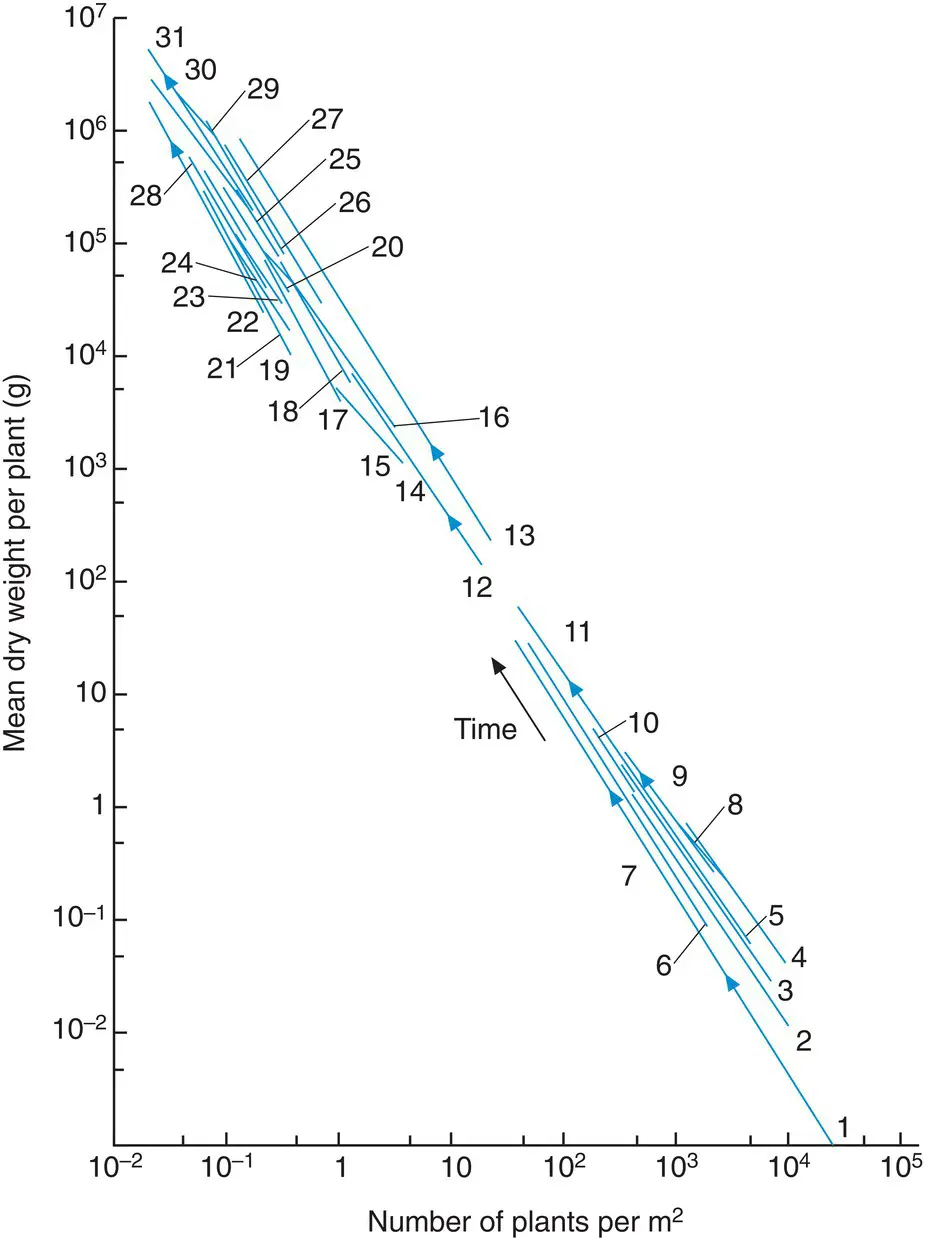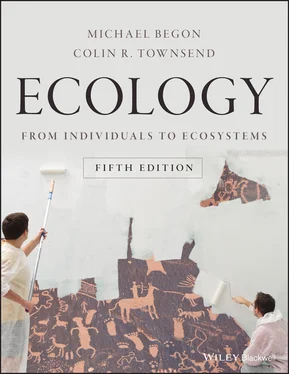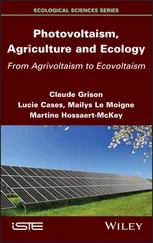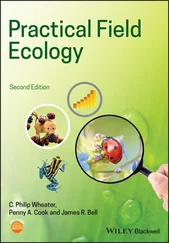Note, however, that there are statistical problems in using Equations 5.22and 5.23to estimate the slope of the relationship in that  is usually estimated as B/N , where B is the total biomass per unit area, and so
is usually estimated as B/N , where B is the total biomass per unit area, and so  and N are inevitably correlated, and any relationship between them is, to a degree, spurious (Weller, 1987). It is therefore preferable to use the equivalent relationships relating overall biomass to density, lacking autocorrelation:
and N are inevitably correlated, and any relationship between them is, to a degree, spurious (Weller, 1987). It is therefore preferable to use the equivalent relationships relating overall biomass to density, lacking autocorrelation:
(5.24) 
or:
(5.25) 
5.9.2 Species and population boundary lines
If we now turn to the third type of study, listed in Section 5.9, we can note that although, again, combinations of density and mean weight for a particular species are being used to generate a relationship between them, it is not a single cohort that has been followed over time, but a series of crowded populations at different densities (and possibly different ages). In such cases, it is more correct to speak not of a thinning line but of a species boundary line – a line beyond which combinations of density and mean weight appear not to be possible for that species (Weller, 1990). Indeed, since what is possible for a species will vary with the environment in which it is living, the species boundary line will itself subsume a whole series of population boundary lines, each of which defines the limits of a particular population of that species in a particular environment (Sackville Hamilton et al ., 1995).
dynamic thinning and boundary lines need not be the same
Thus, a self‐thinning population should approach and then track its population boundary line, which, as a trajectory, we would call its dynamic thinning line – but this need not also be its species boundary line. The light regime, soil fertility, spatial arrangement of seedlings, and no doubt other factors may all alter the boundary line (and hence the dynamic thinning line) for a particular population (Weller, 1990 ; Sackville Hamilton et al ., 1995). Soil fertility, for example, has been found in different studies to alter the slope of the thinning line, the intercept, neither, or both (Morris, 2002).
thinning slopes of −1
The influence of light, in particular, is worth considering in more detail, since it highlights a key feature of thinning and boundary lines. A slope of roughly −3/2 means that mean plant weight is increasing faster than density is decreasing, and hence that total biomass is increasing. But eventually this must stop: total biomass cannot increase indefinitely. Instead, the thinning line might be expected to change to a slope of −1, which would mean that loss through mortality is being exactly balanced by the growth of survivors, such that the total biomass remains constant. This can be seen when the populations of Lolium perenne discussed previously were grown at low light intensities ( Figure 5.36b). A thinning line with a slope of −1 was apparent at much lower densities than it would otherwise be. This emphasises that boundary lines with negative slopes steeper than −1 (whether or not they are exactly −3/2) imply limits to the allowable combinations of plant densities and mean weights that set in before the maximum biomass from an area of land has been reached. Possible reasons are discussed in the next section.
5.9.3 A single boundary line for all species?
Intriguingly, when the thinning and boundary lines of all sorts of plants are plotted on the same figure, they all appear to have approximately the same slope and also to have intercepts (i.e. values of c in Equation 5.24) falling within a narrow range ( Figure 5.37). To the lower right of the figure are high‐density populations of small plants (annual herbs and perennials with short‐lived shoots), while to the upper left are sparse populations of very large plants, including coastal redwoods ( Sequoia sempervirens ), the tallest known trees. Fashions change in science as in everything else. At one time, ecologists looked at Figure 5.37and saw uniformity – all plants marching in −3/2 time, with variations from the norm seen either as ‘noise’ or of only minor interest (e.g. White, 1980). Subsequently, however, serious doubt was cast on the conformity of individual slopes to −3/2, and on the whole idea of a single, ideal thinning line (Weller, 1987 , 1990 ; Zeide, 1987; Lonsdale, 1990). This is reminiscent of discussions we described in Section 3.9about whether there is a general rule (and a common slope) at the heart of a metabolic theory of ecology, and again, there really is no contradiction. On the one hand, the lines in Figure 5.37occupy a very much smaller portion of the graph than one would expect by chance alone. There is apparently some fundamental phenomenon linking this whole spectrum of plant types: not an invariable ‘rule’ but an underlying trend. On the other hand, the variations between the lines are real and important and in as much need of explanation as the general trend.

Figure 5.37 Self‐thinning in a wide variety of herbs and trees.Each line is a different species, and the line itself indicates the range over which observations were made. The blue arrows, drawn on representative lines only, indicate the direction of self‐thinning over time. The figure is based on Figure 2.9of White (1980), which also gives the original sources and the species names for the 31 datasets.
5.9.4 An areal basis for self‐thinning
We proceed, therefore, by examining possible bases for the general trend, and then asking why different species or populations might display their own variations on this common theme. Two broad types of explanation for the trend have been proposed. The first (and for many years the only one) is areal and based on a resource falling on the organisms from above (like light); the second is based on resource allocation in organisms of different sizes. Again, the similarities to the arguments at the heart of a metabolic theory of ecology, discussed in Section 3.9, are clear.
Limiting ourselves for now to plants, the areal argument runs as follows. In a growing cohort, as the mass of the population increases, the leaf area index ( L , the leaf area per unit area of land) does not keep on increasing because beyond a certain point the canopy is full and so L remains constant irrespective of plant density ( N ). It is, in fact, precisely beyond this point that the population follows the dynamic thinning line. We can express this by saying that beyond this point:
(5.26) 
where λ is the mean leaf area per surviving plant. However, the leaf area of individual plants increases as they grow, and so too therefore does their mean, λ. We expect λ, because it is an area, to be related to linear measurements of a plant, such as stem diameter, D , by a formula of the following type:
Читать дальше

 is usually estimated as B/N , where B is the total biomass per unit area, and so
is usually estimated as B/N , where B is the total biomass per unit area, and so  and N are inevitably correlated, and any relationship between them is, to a degree, spurious (Weller, 1987). It is therefore preferable to use the equivalent relationships relating overall biomass to density, lacking autocorrelation:
and N are inevitably correlated, and any relationship between them is, to a degree, spurious (Weller, 1987). It is therefore preferable to use the equivalent relationships relating overall biomass to density, lacking autocorrelation:














